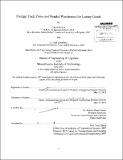Foreign trade zones and bonded warehouses for luxury goods
Author(s)
Petrova, Nadya (Nadya Naydenova); Templeton, A. Todd
DownloadFull printable version (8.421Mb)
Other Contributors
Massachusetts Institute of Technology. Engineering Systems Division.
Advisor
Roberto Perez-Franco.
Terms of use
Metadata
Show full item recordAbstract
We explore and compare the benefits of establishing and operating Foreign Trade Zones (FTZs) and Bonded Warehouses (BWs) for luxury goods in North America, using the case of the distribution network of Ralph Lauren Corporation (RLC). RLC is a luxury brand company with about $7 billion annual revenue. With over 3 million square feet of warehousing facilities in the USA, the company wants to explore potential savings from changing the legal titles of four of its existing inventory holding and transload facilities to either FTZs or BWs while considering the respective complexity and cost of setting up and managing the zones. To eliminate one of the FTZ and BW options, we measured both of their operational fits to the metrics of RLC's facilities. We found out that BWs are not a viable alternative for large-scale facilities such as RLC's because of the complicated Customs and Border Protection control they require. Furthermore, to determine which, if any, of the facilities should be transformed into FTZs, we conducted a cost-benefit analysis and evaluated the Net Present Value of the projects. As a result, we found out that it is financially beneficial to transform two of the four facilities under consideration, leave one in its current state, and explore the future strategic role of the fourth facility to determine the value of its FTZ transformation. We also suggest possible operational opportunities that may increase the FTZ benefits for the RLC North America network.
Description
Thesis (M. Eng. in Logistics)--Massachusetts Institute of Technology, Engineering Systems Division, 2013. Cataloged from PDF version of thesis. Includes bibliographical references (p. 63-64).
Date issued
2013Department
Massachusetts Institute of Technology. Engineering Systems DivisionPublisher
Massachusetts Institute of Technology
Keywords
Engineering Systems Division.